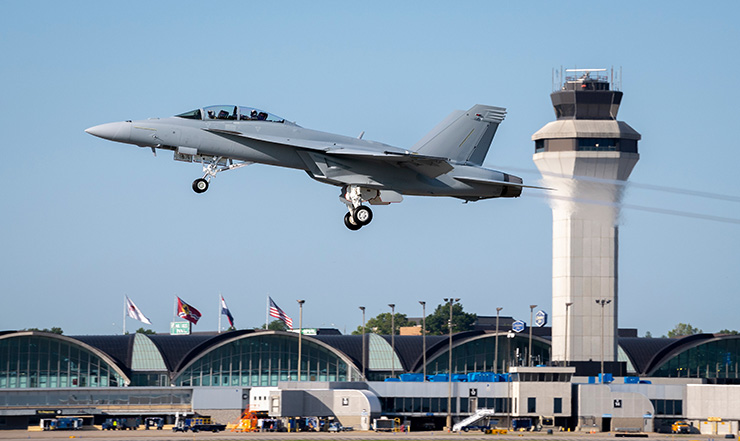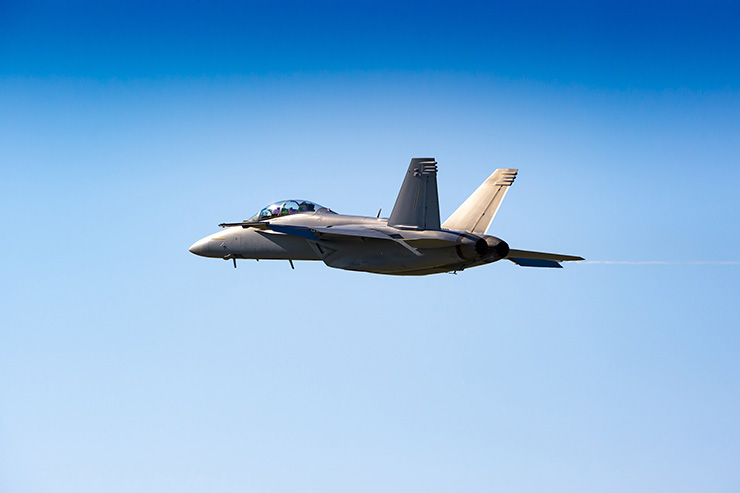
The Indo-Pacific has gained enormous political, strategic, and economic importance and has emerged as a prominent geostrategic landscape in recent years. The strength of the partnership for Indo-Pacific will be determined by the abilities of the countries to work together seamlessly. Commonality and interoperability of defence assets contribute not only towards efficient operations with the partner countries but also offer significant enduring strategic benefits to the partners. In this scenario, the role of naval aviation in defending the region’s and India’s maritime interests is only expected to grow. The Indian Navy continues to shoulder India’s increasing strategic and geopolitical responsibility in the Indian Ocean region. Mission ready and capable, the Indian Navy’s air fleet supports the entire mission spectrum – ranging from countering piracy and asymmetrical warfare to neutralizing maritime terrorism.
In this context, the combat-proven F/A-18 Super Hornet Block III delivers cutting-edge, next-generation multi-role strike fighter capability, outdistancing current and emerging threats well into the future. The Super Hornet has the capability, flexibility and performance necessary to modernize the air prowess for the Indian Navy.
Better synergies and naval aviation cooperation in the Indo-Pacific
The U.S. Navy operates more than 800 Super Hornets and EA-18G Growlers, the electronic attack version of the F/A-18 and have logged over 2.5 million flight hours on the fleet. The Block III configuration is suited to protect India’s maritime interests as it is built to meet the broadest range of missions while benefiting from the upgrades and knowledge related to U.S. naval aviation. We anticipate the Super Hornet opening up opportunities for greater interoperability between the two navies for a more secure Indo-Pacific.
Greater interoperability
Block III’s networking allows the F/A-18 Super Hornet to interface with other assets of the Indian Navy. For example, F/A-18s of the Indian Navy can share data with P-8Is of the Indian Navy or P-8 of U.S. Navy and Royal Australian Air Force to significantly improve the capability of the partner countries for helping secure the Indo-Pacific. Recently, there have been tremendous advancements in unmanned systems that are to be used in a naval aviation environment. In the coming days, as Indian Navy inducts such systems, both the single-seat and two-seat versions of the Super Hornet on the Indian Navy carrier will allow interfacing with unmanned carrier-borne systems more effectively.
Superior economics
The F/A-18 Super Hornet has a very attractive lifecycle cost too. It not only has an affordable acquisition cost, but it costs less per flight hour to operate than any other tactical aircraft in production in the U.S. forces inventory. This is possible because the fighter is designed for ease of maintainability and offers impressive durability with the life of the airframe up to 10,000 hrs. Boeing’s sustainment program – “By India, For India” – is built on the success of existing programs that the company is executing for the Indian Air Force (IAF) and Indian Navy (IN) today. These programs will enable us to develop select capabilities to sustain the Super Hornet out of India.

The Super Hornet is powered by the GE F-414 engine that has clocked cumulatively more than 5 million hours. The same family of engines is powering India’s indigenous Light Combat Aircraft inducted by the Indian Air Force. The commonality in engines would create scale efficiencies for potential sustainment opportunities in India in the future.
Supporting the Atmanirbhar Bharat strategy
Boeing plans to further strengthen its Make in India initiatives, building on a successful track record of contributing to India’s indigenous aerospace and defence ecosystem. As part of this effort, Boeing anticipates $3.6 billion in economic impact to the Indian aerospace and defence industry over the next 10 years, with the F/A-18 Super Hornet as India’s next carrier-based fighter. The economic impact would be over and above Boeing’s current offset obligations and plans in the country. The strategy includes five key pillars:
- Supply Chain Development and Manufacturing: The new plan builds on Boeing’s sourcing of $1 billion annually from over 300 suppliers on parts, assemblies and services from Indian suppliers. Boeing has added several new Micro, Small and Medium Enterprises (MSMEs) suppliers in support of our commitment to Atmanirbhar Bharat, and they account for over 25 percent of our suppliers in India. The plan also envisages potential for additional manufacturing opportunities, including the F/A-18’s Outer Wing and Nose Barrel component manufacturing and assembly. Additionally, Boeing is reviewing several hundred other machined assemblies that could be placed with Indian suppliers.
- Engineering and Technology Transfer: Boeing envisions working closely with industry and the U.S. and Indian governments to share technology and transfer work of the F/A-18 fighter jets in India, based on interest and business case. Boeing will also leverage investments made in the Boeing India Engineering & Technology Centre (BIETC) and its talented pool of 4,000+ engineers and innovators in Bengaluru and Chennai to drive growth and innovation, and advance work in materials, manufacturing technologies and methods, and the “Digital World.” As a part of “Digital World,” new manufacturing processes have been established, and Boeing has unlocked the potential of the Full-Size Determinant Assembly (FSDA) approach for its customers. With the F/A-18, Boeing will continue to explore opportunities to bring FSDA-related advanced technologies to the Indian defence industry.
- Support and training: Boeing will collaborate with the Ministry of Defence and Indian industry to develop long-term and self-reliant sustainment solutions for the Super Hornet fleet to deliver increased aircraft availability and mission readiness. This will be done by leveraging the existing industry ecosystem across key support areas such as On and Off Aircraft Maintenance, Sustaining Engineering, Fleet Operations Support, and Training, and by leveraging the local Maintenance Repair & Overhaul (MRO) capabilities that Boeing Defence India is building.
- Investments: Boeing India employs over 5,000 employees directly, and over 7,000 are employed by key suppliers in India. Boeing’s joint venture with Tata – Tata Boeing Aerospace Limited – manufactures aerostructures for Apache attack helicopters for global customers out of Hyderabad. In addition, foreign direct investment (FDI) of $200 million has been made by Boeing towards aerospace and defence, including a 43-acre state-of-the-art engineering and technology campus under construction in Bengaluru. This campus will be the largest Boeing-owned facility of its kind outside the U.S.
- Impact by Hornet Industry Team: The diversity and strength of the Hornet Industry Team, comprising of General Electric, Northrop Grumman and Raytheon, has the potential to deliver significant benefits to Indian industry. These industry leaders have proven their commitment to India by collaborating with Indian entities and delivering on Atmanirbhar Bharat objectives. The F/A-18 will enhance collaboration with Indian industry by facilitating knowledge transfer and promoting autonomy in operating and maintaining India’s fleet of F/A-18 aircraft. Further, this knowledge transfer may also provide opportunities for India to support F/A-18 fleets around the world through manufacturing and sustainment.
We are confident about the rising importance of the Indian Navy in the Indo-Pacific, and are committed to supporting and enabling its journey.
-The writer is Vice President, India Business Development, Boeing Defense, Space & Security and Global Services








